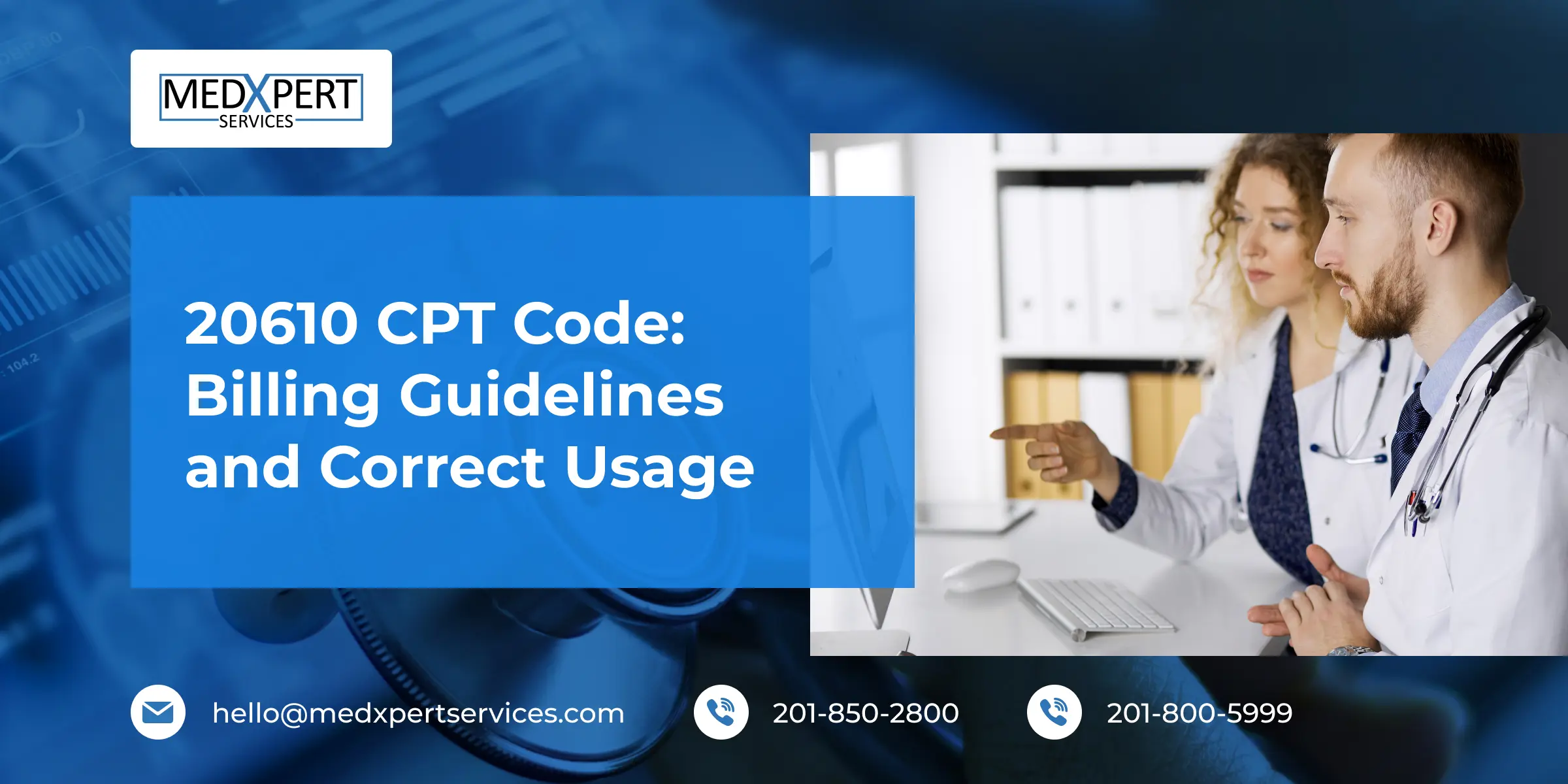Healthcare providers, practice managers, and billing teams often encounter claim denials or underpayments when utilizing the CPT. This occurs because the regulation pertains to a specific situation, the aspiration or injection of a major joint or bursa without ultrasound, and misapplication might result in audits or revenue loss.
According to recent data, the global market in joint pain injections is expected to reach USD 7.9 billion in 2025. Additionally, the Centers for Medicare & Medicaid Services recommend billing only one unit of CPT20610 for joint aspiration and injection in the same session.
This article provides a comprehensive overview of the CPT 20610 code for orthopedists, rheumatologists, medical coders, billers, RCM specialists, and clinical administrators, including what it covers, when to use it, how to apply modifiers correctly, linking proper ICD-10 codes, and preventing denials.
20610 CPT Code Overview
CPT 20610 is used to describe aspiration or injection of a large joint or bursa without ultrasound guidance. This section outlines its function and the joints to which it applies, allowing providers and billing teams to use it effectively.
Description and Purpose
CPT 20610 describes procedures in which a healthcare provider drains fluid from or injects medicine into a major joint or bursa. It is often used to treat bursitis, osteoarthritis, and joint irritation. This code ensures that payment claims are accurately reported, particularly in orthopedics and rheumatology.
- Used for aspiration or therapeutic injections in the absence of ultrasound guidance.
- Supports the diagnostic examination of joint diseases.
- Helps to reduce pain, swelling, and inflammation.
- Only one unit of CPT 20610 is paid per joint and session.
Applicable Joints
CPT 20610 applies to major joints or bursae. Common examples include:
1. Shoulder
2. Knee
3. Hip
4. Subacromial bursa
Related CPT Codes: CPT 20610 Code
This section shows CPT codes that have a strong connection to the 20610 CPT code. Understanding these codes helps healthcare professionals, coders, and billing teams ensure appropriate documentation and payment.
CPT Codes for Ultrasound-Guided Procedures
These CPT codes cover joint or bursa injections with ultrasound assistance to increase needle placement accuracy and documentation.
| CPT Code | Description | Difference from 20610 CPT code |
| 20611 | Injection or aspiration of a major joint or bursa with ultrasound guidance | Uses imaging, unlike 20610, which is without ultrasound |
| 20606 | Injection or aspiration of a small joint or bursa with ultrasound guidance | Targets small joints, imaging required |
| 20604 | Injection or aspiration of a small joint or bursa without ultrasound guidance | Smaller joint focus, similar technique to 20610 |
CPT Codes for Other Joint-Related Procedures
These CPT codes cover injections or aspirations performed on structures other than major joints, such as tendons, ligaments, or small joints.
| CPT Code | Description | Key Notes |
| 20550 | Injection of the tendon sheath, ligament, or ganglion cyst | Focused on tendon sheaths, not major joints |
| 20551 | Multiple injections of the tendon sheath or ligament | For many sites, separate from 20610 applications |
| 20552 | Therapeutic injection(s) of large joint(s) without ultrasound guidance | Similar to 20610, but may involve different billing criteria |
CPT Code 20610 Modifiers
Using correct modifiers with the CPT 20610 code is essential for proper billing and reimbursement. This section describes the most frequent and other key modifiers applicable to joint aspiration or injection treatments.
Common Modifiers: CPT 20610
Commonly used modifiers for CPT 20610 include:
| Modifier | Meaning | When to Use |
| RT | Right Side | When the procedure is performed on the right joint or bursa. |
| LT | Left Side | When the procedure is performed on the left joint or bursa. |
| 50 | Bilateral Procedure | When the same procedure is performed on both sides of the body. |
Other Important Modifiers: CPT 20610
Other modifiers may be applied depending on the clinical scenario:
| Modifier | Meaning | When to Use |
| 51 | Multiple Procedures | Multiple Procedures |
| 59 | Unique Procedural Service | When the procedure is separate and unrelated to other services on the same day. |
| 76 | Repeat Procedure by Same Physician | When the same physician repeats the procedure on the same day. |
| 77 | Repeat Procedure by Another Physician | When a different physician repeats the procedure on the same day. |
| 79 | Unrelated Procedure During Postoperative Period | When a different, unrelated procedure is performed during the postoperative period. |
| 25 | Significant, Separately Identifiable E/M Service | When a significant E/M service is performed on the same day as the procedure. |
| 24 | Unrelated E/M Service During Postoperative Period | When an E/M service unrelated to the original procedure is performed during the postoperative period. |
CPT 20610 vs 20611: What is the Difference
- This section compares CPT 20610 and 20611 to assist healthcare practitioners, coders, and billing experts in selecting the appropriate code for joint aspiration or injection treatments.
Key Differences
CPT codes 20610 and 20611 are used for joint or bursa injections and aspiration. The key distinction is in imaging guidance.
- CPT code 20610 is used when a procedure is conducted without the use of ultrasound guidance.
- CPT Code 20611: Used when an ultrasound is used to detect a joint or bursa.
- Both codes include key joints such as the hip, shoulder, and knee.
- CPT 20611 requires ultrasound documentation, which affects billing and reimbursement.
- Misuse of these codes might result in rejections or delayed payments.
Choosing the Correct Code
Selecting the proper code ensures accurate reimbursement and compliance:
1. Verify if ultrasonic guidance was utilized throughout the surgery.
2. Confirm that the joint or bursa was treated (CPT 20610 is restricted to major joints).
3. Use suitable modifiers, such as RT, LT, or 50, as necessary.
4. Document the process completely, including aspiration, injection, and clinical reason.
Conclusion
The appropriate use of CPT 20610 assures reimbursement, prevents unnecessary rejections, and provides accurate clinical documentation. Healthcare providers and billing teams must validate the use of ultrasonography guidance, select appropriate modifiers, and describe the aspiration purpose. Misuse of this code may result in claim reviews or late payments. Understanding the distinction between CPT 20610 and associated codes promotes accurate billing. Accurate coding promotes revenue integrity and quality patient care.
FAQs
What is the 20610 CPT code used for?
20610 CPT code is used for a therapeutic or diagnostic injection into a major joint or bursa, such as the shoulder, hip, or knee (without ultrasound guidance).
Can ultrasound guidance be billed with 20610?
No. If ultrasound guidance is used and documented, the correct code is 20611, not 20610.
What documentation is required to support 20610?
Clinical notes must include the joint injected, medication name and dosage, medical necessity, and the provider’s signature.
Can I bill 20610 with fluoroscopy or CT guidance?
Yes. Report the appropriate guidance code separately (e.g., 77002 for fluoroscopy or 77012 for CT), and documentation meets payer requirements.
How often can 20610 be billed for the same joint?
Payers may limit frequency (e.g., every 3 months). Always verify payer-specific frequency rules to avoid denials.
















